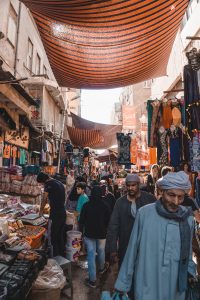Tourism has been doing well in Egypt. By the end of last year, revenue from visitors reached all-time highs thanks to major reforms led by then Minister of Tourism Rania Al Mashat. The United Nations World Tourism Organization (UNWTO) forecasts that the number of tourists will increase from 13 million in 2019 to more than 15 million in 2020. That would be an all-time high, up from 11.336 million arrivals in 2018, according to Trading Economics.

“The minister’s choice of strong international media partners […] had such a great impact on the rise of the number of visitors to Egypt,” says Moataz Sedky, co-chair of AmCham’s Travel & Tourism Committee. “Also, changing the old methods of promoting Egypt and relying instead on the direct impact of the people-to-people [approach], such as high-profile social media influencers, had a dramatic effect on tourism.”
Further fueling a rise in arrivals will likely be global enthusiasm surrounding the opening of the Grand Egyptian Museum. It will be “the largest museum in the world dedicated to a single civilization,” wrote Lindsey Galloway for the BBC in a January article titled “Why 2020 is the Year to Visit Cairo.” Sedky says the museum will be one of the top 12 tourist destinations in 2020. “Meanwhile, the number of travelers to Sharm El Sheikh should increase by 20 percent after the [United Kingdom] decision to lift its travel ban,” he says. “Also, Russia will soon resume charter flights to Sinai for the first time since 2015.”
However, the Travel and Tourism Competitiveness Report (TTCR) 2019, a biannual publication of the World Economic Forum, gives Egypt mixed scores. While cited as one of the most improved destinations, Egypt still ranks 65th out of 140 nations and scores near the bottom in openness to other countries. Addressing Egypt’s specific concerns as well as avoiding global issues such as overtourism would not only boost tourism but make it sustainable.
Measuring success
The TTCR report breaks down each country into four categories, each with a series of pillars.
The first category is creating an enabling environment, which “captures the general conditions necessary for operating in a country.” That category is related to the business of tourism, including business environment, safety and security, health and hygiene, human resources and ICT readiness.
The second category deals with government policies. It includes prioritizing travel and tourism, international openness, price competitiveness and environmental stability.

The third tackles government infrastructure investments in air transport, ground and port infrastructure and tourist services.
The last category relates to the sights and resources of a country, including geographical location, history and attractiveness to business travelers.
Regional boom
According to TTCR, scores for 12 of the 15 MENA countries have improved since the 2017 report. “The region was able to slightly outpace the global average in competitiveness growth,” it said. “This is particularly important given that… [travel and tourism] accounts for a greater share of regional GDP than in any of the other four regions.”
Despite that improvement and the importance of the sector to regional GDP, tourism still suffers from significant problems, according to TTCR. It noted that more needs to be done to protect heritage sites, for example. A weak digital presence promoting natural, cultural and entertainment activities “indicates potential gaps in marketing and traveler perceptions,” said the report.
Meanwhile, tourists don’t rate the region highly due to perceptions of a lack of safety and security, and bureaucratic entrance procedures, noted the WEF report, adding that airline connections are limited compared to other regions.
On the plus side, price competitiveness has improved, “amplifying MENA’s single biggest advantage relative to the global average.” The report cited Egypt, Algeria, Iran and Tunisia as noticeably more affordable for tourists. “Reductions in ticket taxes and airport charges, as well as lower hotel prices, have primarily driven regional price competitiveness in recent years.”
The TTCR noted the region as a whole has worked to improve tourism infrastructure, safety and security, and government support. However, the report said, “world-class infrastructure remains concentrated among the Arab states of the Persian Gulf.”
Lastly, the region is missing out by marginalizing the presence of women in the sector, which shrinks the labor and skills pool, as well as limits women-only services, said the report.
Egypt’s rankings
For the past nine years, Egypt has focused on reviving tourism to its pre-2011 heydays. Its lowest point was in 2016, when revenues were $3.8 billion just before the floating of the currency, according to the Central Bank.
However, mainly thanks to the ministry’s Egypt Tourism Program (E-TRP) announced in 2018, tourism revenues in 2019 topped $12.57 billion compared to $12.5 billion in 2010.
Egypt’s rank increased from 74th in the 2017 report to 65th out of 140 countries. “It had the best improvement among countries ranked 36 to 70,” said the TTCR. It is currently ranked as the best tourist destination in Africa and fourth-best in MENA.
That improvement, according to the TTCR, is because Egypt was the top scorer in MENA in the environmental sustainability, cultural resources and business travel pillars. It is also the most improved in safety and security, ground and port infrastructure, and natural resources.

Globally, Egypt was among the top 20 percent of countries in cultural resources, business travel and price competitiveness. It ranked in the top 40 percent in air transport infrastructure, environmental sustainability and government prioritization of the sector. In business environment, ground and port infrastructure, and natural resources, it ranked among the top 60 percent.
In its analysis, the TTCR report generally praised the government’s promotion of tourism. That includes the Grand Egyptian Museum and the EGP 50 billion budget to support tourism announced in December. Other notable improvements, according to the TTCR, are rising government spending on tourism, enhancing the country’s brand, improved airline connectivity, and better ground and port infrastructure.
Needs fixing
The TTCR, however, ranks Egypt in the bottom 40 percent in safety and security, health and hygiene, human resources and labor, tourist service infrastructure and ICT readiness. Meanwhile, the country is in the bottom 20 percent in international openness.
One major issue is safety and security, where Egypt ranks 112th out of 140 in the report, which cited “incidents of terrorism (135th). It remains one of Egypt’s most acute deterrents.”
Other issues include tighter visa requirements, where Egypt’s rank went from 51 in 2017 to 123 in 2019. “That has not helped induce the flow of tourists, with the country remaining one of the least internationally open in the world,” wrote the report.
Long-term problem
If the UNWTO’s forecasts are correct, Egypt is entering into uncharted territory serving 1.25 million visitors a month compared to 944,000 in 2018.
The TTCR recommends that governments work on all 14 pillars simultaneously. “The data suggests that a holistic, systems-led approach to tourism strategy is required to truly perform successfully on the global rankings.”
One example is the natural assets pillar, for which Egypt is well-known. “The assets that this pillar measures cannot be bought or created,” said the report, “but if not managed well can be destroyed rapidly.”
Overtourism could become an issue within a few years, assuming tourism continues to boom. “Luckily, overtourism is not yet in Egypt as much as in Europe, which usually results in anti-tourism,” says Sedky. That can prove to be a tricky situation.
On the one hand, the sector is vital for securing foreign currency and generating employment. “Addressing a growth of demand and strained capacity,” says Sedky, “is somewhat paradoxical.”







